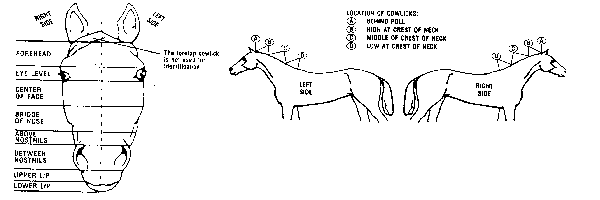
SIMPLE GUIDE TO PROPER THOROUGHBRED IDENTIFICATION
by Christy Gindt
There are many cases in which the mystique of Jockey Club language has confused many a horsemen, owner, trainer, etc. Taking the time to ensure your horse matches its papers should be a part of the trainer or breeder's regular routine. This simple self-help guide to thoroughbred identification will assist in avoiding the risk of being scratched from a race, along with wasted time, money, and stress. Horse Identification seems like an easy enough task, just look at the horse and match the markings from its papers. Unfortunately, what may look like a cowlick behind poll, may actually be a cowlick high on the crest of neck to a professional identifier. Although each identifier may have different perceptions on what constitutes a formal Jockey Club Registration Certificate correction, this guide will address the basic procedures used in determining proper identification in California.
Sex & Color - Thoroughbreds have six color descriptions; bay, dark bay/brown, black, chestnut, roan and gray. The latter two are often interchangeable. In regards to the sex of the horse, a colt may be changed to gelding at any time after registration without a need for a formal Jockey Club correction. In the case of a colt being registered as a filly, and the horse's certificate will definitely need correcting.
Cowlicks (or whorls) - Every Thoroughbred has at least two neck cowlicks and at least one forehead cowlick not including the foretop. Cowlicks never move and are present from the birth of the foal which often makes cowlicks the most important identifying feature. The following Jockey Club diagrams determine the proper placement of cowlicks. If no cowlicks are drawn in on the original Jockey Club will automatically put "Cowlicks behind poll" (A on the diagram), if in fact the cowlicks are at another location on the neck, the horses with no white markings, cowlicks must be in exactly defined.

Diagram 1
White Markings - White markings are described by the shape, size, and placement on the head, body, and legs of a horse is stated to have "no white markings" and there are a few scattered white hairs in the forehead or anywhere on the body, these horses will need to be formally corrected.
Corrections - If a horse does not match its papers, a Jockey Club Correction/Duplicate form may be obtained either from a Jockey Club representative, the Horse Identifier's office or by requesting a form from the Jockey Club. When correcting a horse for color, markings, or sex, the following are required: four clear photographs of each side of the horse with all four legs visible, a check or money order for $50.00 payable to the Jockey Club, a completed correction form with signature and the marks drawn and described. If at any time you are not sure if a horse truly matches its papers, it is advisable to ask an identifier to take a look at the horse.
For further information contact your local Jockey Club Representative, Dianne Piper or The Jockey Club 1-800-444-8521.